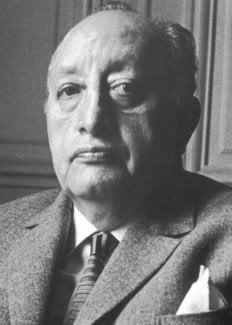Miguel Angel Asturias
Biographical

Miguel Angel Asturias (1899-1974) was born in Guatemala and spent his childhood and adolescence in his native country. He studied for his baccalaureate at the state high school and later took a law degree at the University of San Carlos. His thesis on “The Social Problem of the Indian” was published in 1923.
After he finished his law studies, he founded with fellow students the Popular University of Guatemala, whose aim was to offer courses to those who could not afford to attend the national university. In 1923 he left for Europe, intending to study political economy in England. He spent a few months in London and then went to Paris, where he was to stay for ten years. At the Sorbonne he attended the lectures on the religions of the Mayas by Professor Georges Raynaud, whose disciple he became. Also, as correspondent for several important Latin American newspapers, he travelled in all the Western European countries, in the Middle East, in Greece, and in Egypt.
In 1928 Asturias returned for a short time to Guatemala, where he lectured at the Popular University. These lecture were collected in a volume entitled La arquitectura de la vida nueva (Architecture of the New Life), 1928. He then went back to Paris, where he finished his Leyendas de Guatemala (Legends of Guatemala), 1930. Published in Madrid, the book was translated into French by Francis de Miomandre, who sent his translation to Paul Valéry. The French poet was greatly impressed, and his letter to Miomandre was used as the preface to the 1931 edition published in the Cahiers du Sud series. The same year, Leyendas de Guatemala received the Silla Monsegur Prize, a reward for the best Spanish-American book published in France.
During his stay in Paris from 1923 to 1933, Asturias wrote his novel El Señor Presidente (The President), which slashed at the social evil and malignant corruption to which an insensitive dictator dooms his people. Because of its political implications Asturias was unable to bring the book with him when, in 1933, he returned to Guatemala, which at the time was ruled by the dictator Jorge Ubico. The original version was to remain unpublished for thirteen years. The fall of Ubico’s regime in 1944 brought to the presidency Professor Juan José Arévalo, who immediately appointed Asturias cultural attaché to the Guatemalan Embassy in Mexico, where the first edition of El Señor Presidente appeared in 1946.
In late 1947, Asturias went to Argentina as cultural attaché to the Guatemalan Embassy and, two years later, obtained a ministerial post. While in Buenos Aires, he published Sien de alondra (Temple of the Lark), 1949, an anthology of his poems written between 1918 and 1948. In 1948 he returned to Guatemala for a few months, during which time he wrote his novel Viento fuerte (Strong Wind), 1950, an indictment of the effect of North American imperialism on the economic realities of his country. That same year, the second edition of El Señor Presidente was published in Buenos Aires.
When the government of President Jacobo Arbenz Guzman fell in 1954, Asturias went into exile in Argentina, his wife’s native country, where he remained until 1962. A year later, the Argentine publisher Losada brought out his novel Mulata de tal (Mulata). This story, a surrealistic blend of Indian legends, tells of a peasant whose greed and lust consign him to a dark belief in material power from which, Asturias warns us, there is only one hope for salvation: universal love.
In 1966 Asturias was awarded the Lenin Peace Prize. In the same year, he was appointed the Guatemalan ambassador to France by President Julio Mendez Montenegro.
This autobiography/biography was written at the time of the award and first published in the book series Les Prix Nobel. It was later edited and republished in Nobel Lectures. To cite this document, always state the source as shown above.
Miguel Asturias died on June 9, 1974.
Nobel Prizes and laureates
Six prizes were awarded for achievements that have conferred the greatest benefit to humankind. The 14 laureates' work and discoveries range from quantum tunnelling to promoting democratic rights.
See them all presented here.
